Influence of Linear Springing on the Fatigue Damage of Ultra Large Ore Carriers
Abstract
:1. Introduction
2. Method of Solution for Hydroelasticity
3. Calculation of Fatigue Damage Accounting for the Effect of Wave
3.1. Spectral Analysis Method for the Calculation of Fatigue Damage
3.2. Fatigue Damage Due to Stress Induced by Vertical Wave Bending Moment
3.3. The Total Structural FATIGUE Damage Including the Effect of Springing
4. Numerical Configurations and Parameters
5. Results and Analysis
5.1. Influence of Hull Length
5.2. Influence of Structure Damping
5.3. Influence of Sea State
5.4. Influence of Navigation Speed
5.5. Influence of Wave Heading
5.6. Influence of Loading Condition
6. Conclusions
- (1)
- Based on a 3D linear frequency domain hydroelasticity analysis method, and when combined with a spectral analysis method for strength assessment of ship hull structure, a method is established for evaluating the structure fatigue damage of ultra large ore carriers.
- (2)
- The springing response may make significant contribution to the structure fatigue damage of ultra large ore carrier. Vessels of a larger length usually have larger fatigue damage ratio. In particular, the damage ratio is 1.184 for the smallest ship investigated, while 1.784 for the largest.
- (3)
- The structural damping has a large influence on the peak value of the springing response, and thus significantly affects the fatigue damage of ultra large ore carriers. For the 400,000 DWT ore carrier, the peak value of the springing response decreases rapidly when the structural damping coefficient increases from 0.01 to 0.03. However, the rate of decrease slows down after the structural damping coefficient exceeds 0.05.
- (4)
- The springing effect on the structural fatigue damage is pronounced in moderate sea states. The results that were obtained for the fatigue damage of the four ultra large ore carriers show that, when the range of zero-cross period is 4.5~12.5 s and with wave height of 3.5~10.5 m, the fatigue damage due to springing significantly increases. However, the significant effect is observed in other sea states.
- (5)
- According the results, navigation at a relatively high speed in moderate mild seas results in larger fatigue damage than that at a reduced speed in high seas.
- (6)
- Another observation is that the fatigue damage is significant when the when the wave heading ranges from −60° to +60°.
- (7)
- As for the loading condition, no distinct difference is observed in the effect of linear springing on the fatigue damage between the full loading and the ballast condition.
Author Contributions
Acknowledgments
Conflicts of Interest
Appendix A
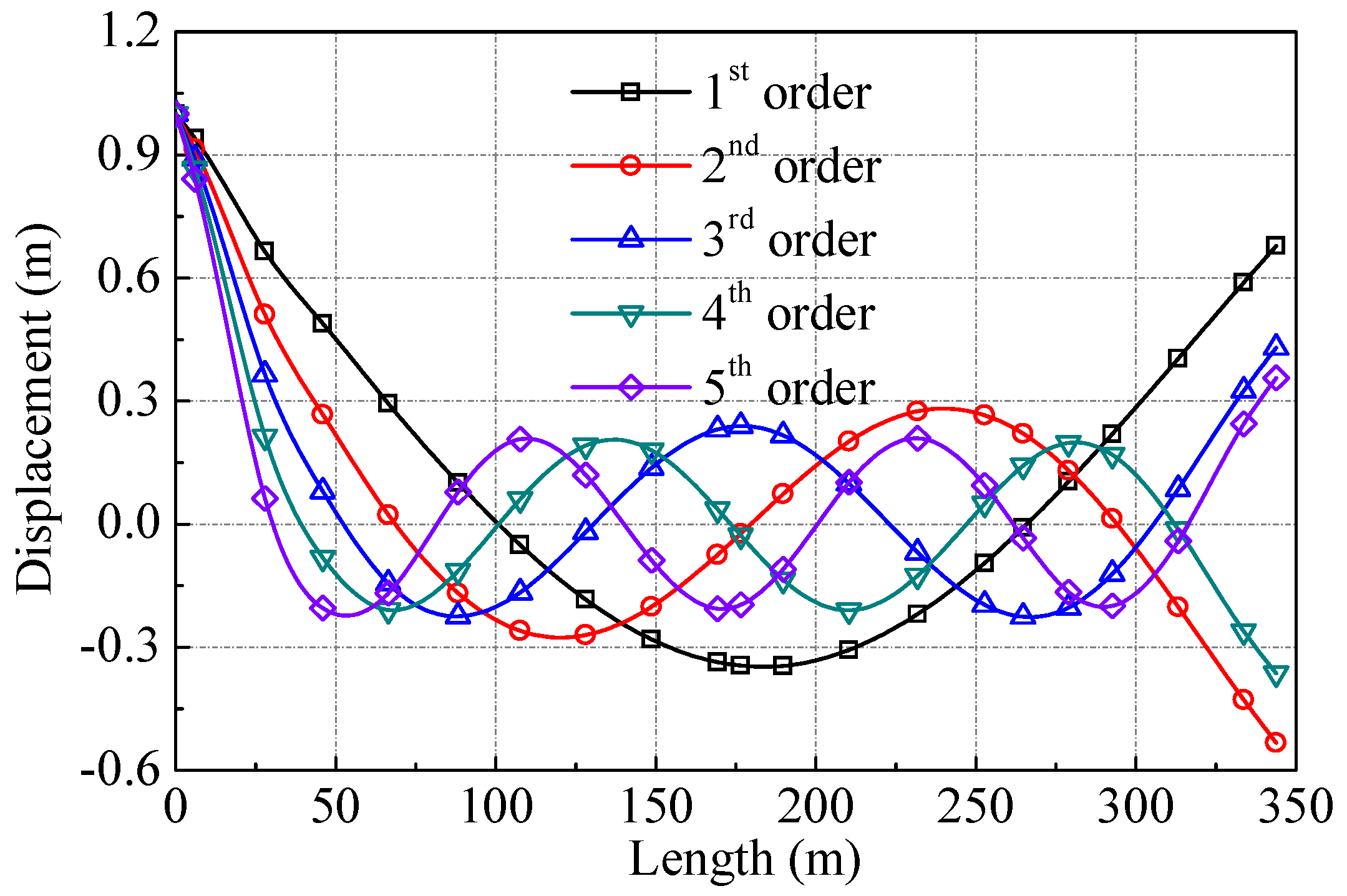

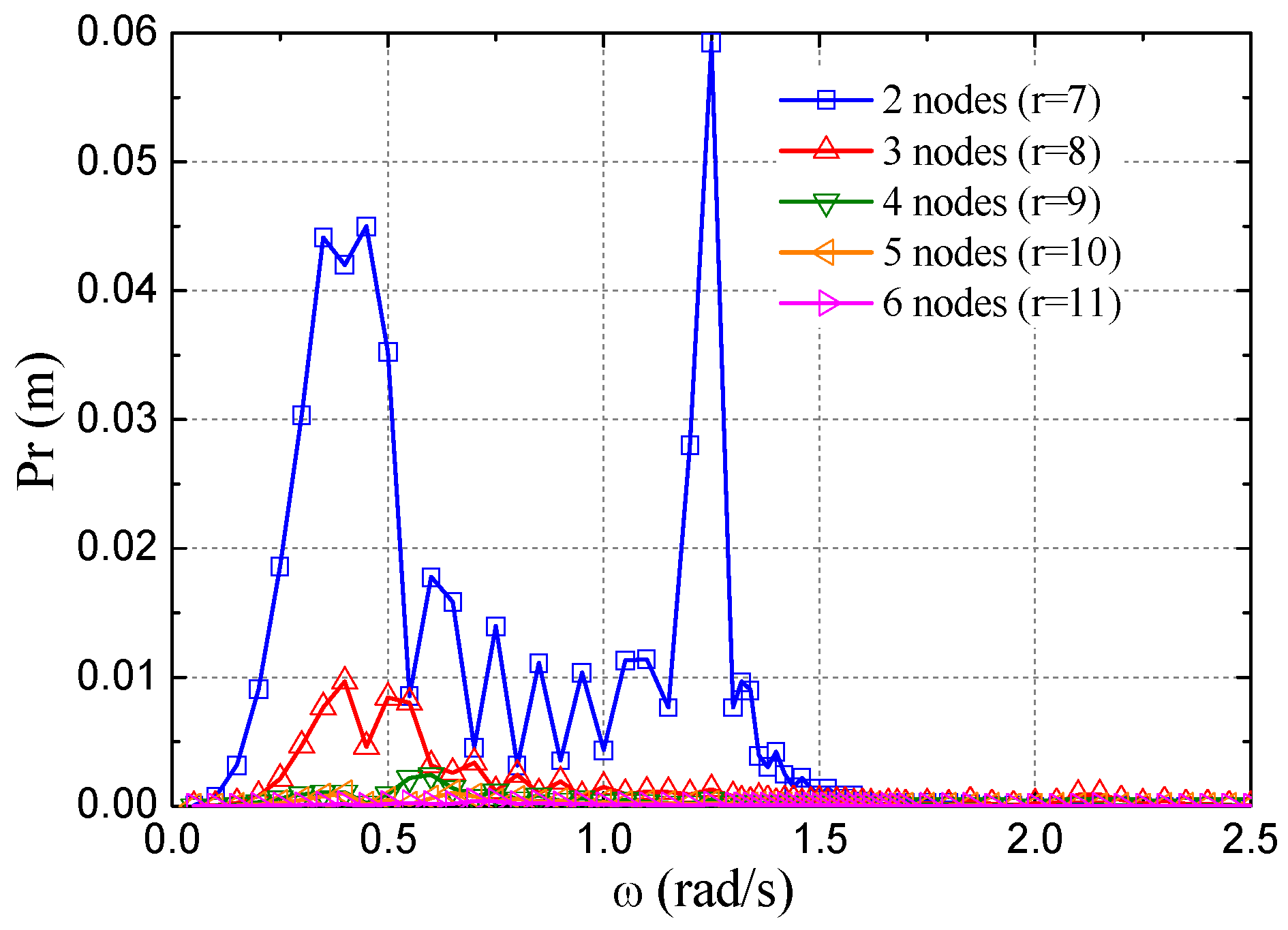
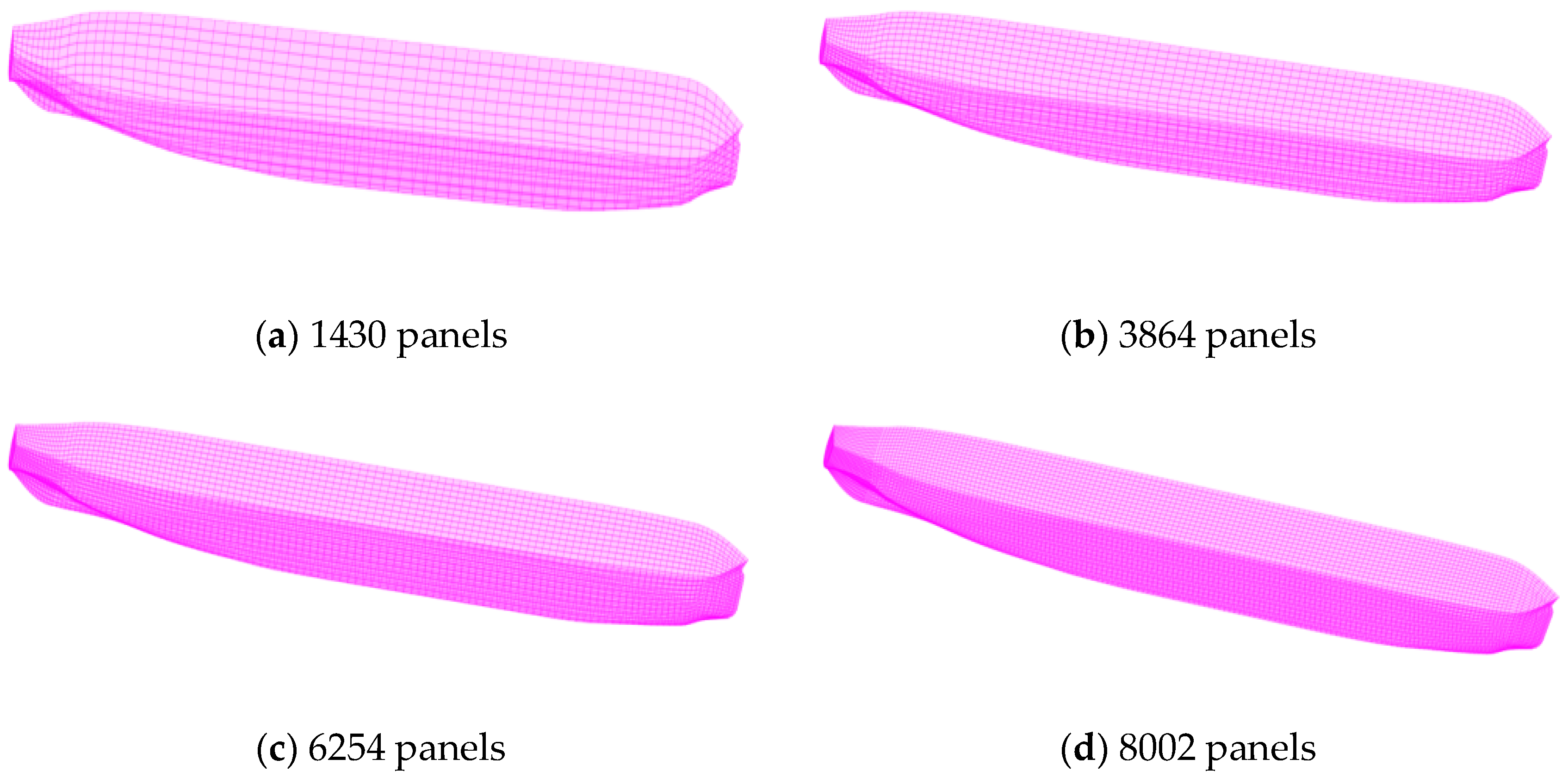
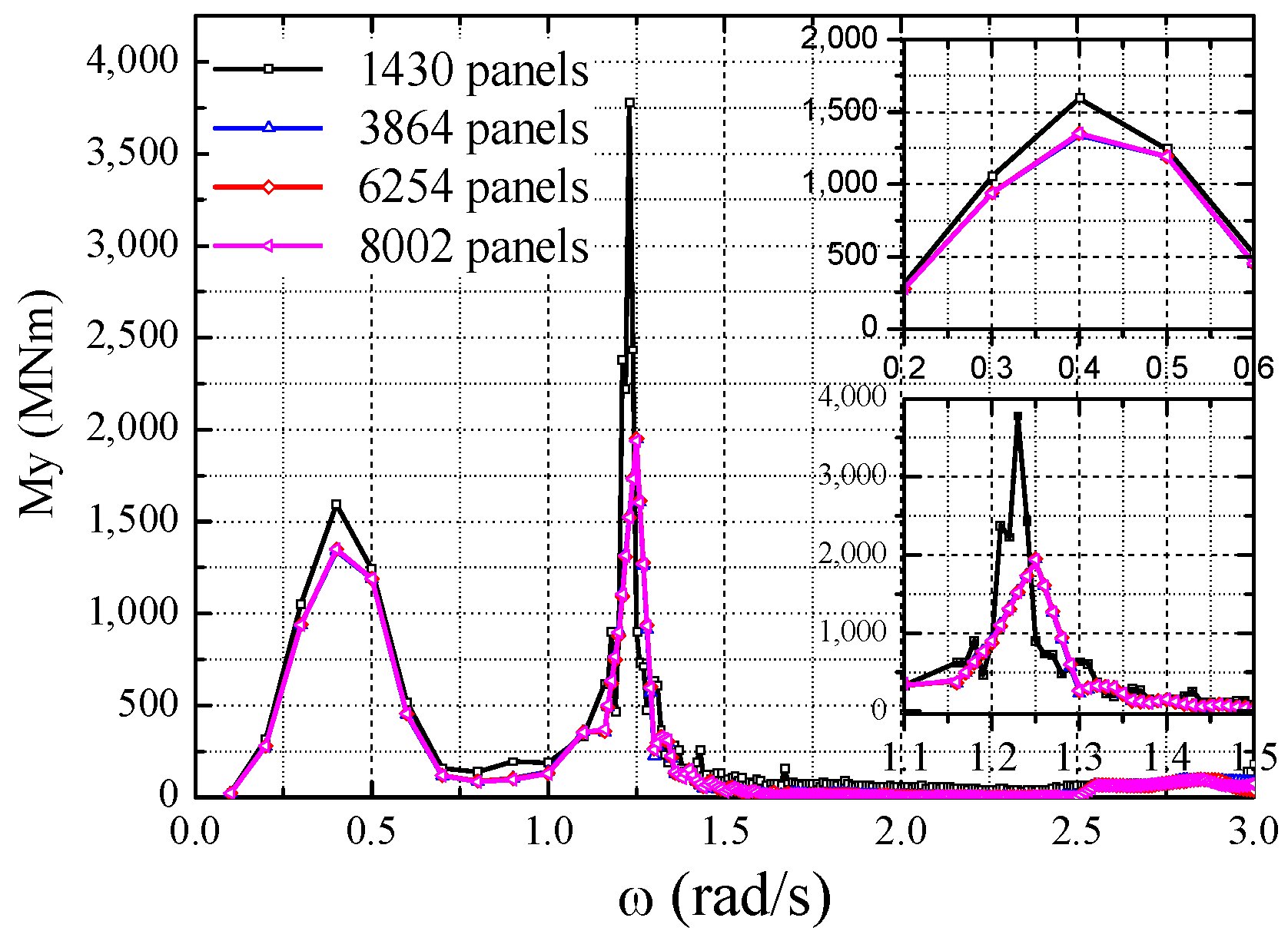
| 250,000 DWT OC | 300,000 DWT OC | 388,000 DWT OC | 400,000 DWT OC | |
|---|---|---|---|---|
| Full loading condition | 6960 | 7400 | 7856 | 8002 |
| Ballast condition | 6342 | 6858 | 7232 | 7438 |
References
- Hirdaris, S.E.; Bakkers, N.; White, N.; Temarel, P. Service factor assessment of a great lakes bulk carrier incorporating the effects of hydroelasticity. Mar. Technol. 2009, 46, 116–121. [Google Scholar]
- Hu, J.J.; Wu, Y.S.; Tian, C.; Wang, X.L.; Zhang, F. Hydroelastic analysis and model tests on the structural responses and fatigue behaviours of an ultra-large ore carrier in waves. Proc. Inst. Mech. Eng. Part M J. Eng. Marit. Environ. 2012, 226, 135–155. [Google Scholar] [CrossRef]
- Kim, S.P.; Yu, H.C.; Hong, S.Y. Segmented model testing and numerical analysis of wave-induced extreme and springing loads on large container carriers. In Proceedings of the 20th International Offshore and Polar Engineering Conference, Beijing, China, 20–25 June 2010. [Google Scholar]
- Choi, J.H.; Jung, B.H.; Lee, Y.W.; Bigot, F.; Malenica, S.; Chung, Y.S. Evaluation of springing-induced hull girder loads for ultra large containership and ore carrier. In Proceedings of the 20th International Offshore and Polar Engineering Conference, Beijing, China, 20–25 June 2010. [Google Scholar]
- Storhaug, G.; Moan, T. Springing/whipping Response of a large Ocean-going Vessel Investigated by an Experimental Method. In Proceedings of the 26th International Conference on Offshore Mechanics and Arctic Engineering, San Diego, CA, USA, 10–15 June 2007. [Google Scholar]
- Storhaug, G.; Vidic-Perunovic, J.; Rüdinger, F.; Holtsmark, G.; Helmers, J.B. Springing/whipping response of a large ocean going vessel—A comparison between numerical simulations and full scale measurements. In Hydroelasticity in Marine Technology; Department of Engineering Science: Oxford, UK, 2003; pp. 117–131. [Google Scholar]
- Drummen, I.; Storhaug, G.; Moan, T. Experimental and numerical investigation of fatigue damage due to wave-induced vibrations in a container ship in head seas. J. Mar. Technol. 2008, 13, 428–445. [Google Scholar] [CrossRef]
- Moe, E.; Holtsmark, G.; Storhaug, G. Full scale measurements of the wave induced hull girder vibrations of an ore carrier trading in the North Atlantic. In Proceedings of the Conference on Design and Operation of Bulk Carriers, London, UK, 18–19 October 2005; Royal Institution of Naval Architects: London, UK, 2005. [Google Scholar]
- Wang, X.L.; Gu, X.K.; Hu, J.J.; Shen, J.W. Hull Structure Wave-Induced Vibration and the Fatigue Damage; China Ship Scientific Research Center Report; China Ship Scientific Research Center: Wuxi, China, 2012. [Google Scholar]
- Li, H.; Wang, D.; Zhou, C.M.; Zhang, K.H.; Ren, H.L. Springing Responses Analysis and Segmented Model Test on a 550,000 Dead Weight Tonnage Ore Carrier. J. Offshore Mech. Arct. Eng. 2018, 140, 041301. [Google Scholar] [CrossRef]
- Slocum, S.; Troesch, A.W. Nonlinear Ship Springing Experiments; Report No. 266; The University of Michigan, Department of Naval Architecture and Marine Engineering: Ann Arbor, MI, USA, 1983. [Google Scholar]
- Vidic-Perunovics, J.; Jensen, J.J. Non-linear springing excitation due to a bidirectional wave field. Mar. Struct. 2005, 18, 332–358. [Google Scholar] [CrossRef]
- Shao, Y.; Faltinsen, O.M. A numerical study of the second-order wave excitation of ship springing by a higher-order boundary element method. Int. J. Nav. Archit. Ocean Eng. 2014, 6, 1000–1013. [Google Scholar] [CrossRef]
- Bishop, R.E.D.; Price, W.G. Hydroelasticity of Ships; Cambridge University Press: Cambridge, UK, 1979; pp. 120–236. [Google Scholar]
- Salvensen, N.; Tuck, E.O.; Faltinsen, O. Ship motion and sea loads. Trans. SNAME 1970, 70, 250–287. [Google Scholar]
- Wu, Y.S. Hydroelasticity of Floating Bodies. Ph.D. Thesis, Brunel University, London, UK, 1984. [Google Scholar]
- Price, W.G.; Wu, Y.S. Structural responses of a SWATH or multi-hulled vessel traveling in waves. In Proceedings of the International Conference on SWATH Ships and Advanced Multi-hulled Vessels, London, UK, 17–19 April 1985; Royal Institution of Naval Architects: London, UK, 1985. [Google Scholar]
- Bishop, R.E.D.; Price, W.G.; Temarel, P.A. Hypothesis concerning the disastrous failure of the Onomichi—Maru. R. Inst. Nav. Archit. Trans. 1985, 127, 169–186. [Google Scholar]
- Bishop, R.E.D.; Price, W.G.; Temarel, P.A. Theory on the loss of MV Derbyshire. R. Inst. Nav. Archit. Trans. 1991, 133, 389–453. [Google Scholar]
- Senjanović, I.; Malenica, Š.; Tomašević, S. Investigation of ship hydroelasticity. Ocean Eng. 2008, 35, 523–535. [Google Scholar] [CrossRef]
- Adenya, C.A.; Ren, H.L.; Li, H.; Wang, D. Estimation of Springing Response for 550 000 DWT Ore Carrier. J. Mar. Sci. Appl. 2016, 15, 260–268. [Google Scholar] [CrossRef]
- Bishop, R.E.D.; Price, W.G.; Wu, Y.A. General Linear Hydroelasticity Theory of Floating Structures Moving in a Seaway. Philos. Trans. R. Soc. A Math. Phys. Eng. Sci. 1986, 316, 375–426. [Google Scholar] [CrossRef]
- Xia, J.Z.; Wu, Y.S. A general interface condition of fluid solid coupling problem. Ship Perform. Res. 1993, 2, 15–22. [Google Scholar]
- Miner, M.A. Cumulative Damage in Fatigue. J. Appl. Mech. 1945, 12, 159–164. [Google Scholar]
- Bureau Veritas. Spectral Fatigue Analysis Methodology for Ships and Offshore Units; Bureau Veritas: Neuilly-sur-Seine, France, 2008. [Google Scholar]
- Gu, X.K.; Moan, T. Long Term Fatigue Damage of Ship Structure under Non-Linear Wave Loads. J. Mar. Technol. 2002, 39, 85–104. [Google Scholar]
- Wirsching, P.H. Fatigue reliability for offshore Structures. J. Struct. Eng. 1984, 110, 2340–2355. [Google Scholar] [CrossRef]
- Jiao, G.; Moan, T. Probabilistic analysis of fatigue due to Gaussian load processes. Probab. Eng. Mech. 1990, 5, 76–83. [Google Scholar] [CrossRef]
- American Bureau of Shipping. Guidance Notes on Springing Assessment for Container Vessel; American Bureau of Shipping: Houston, TX, USA, 2014. [Google Scholar]
- American Bureau of Shipping. Guidance Notes on Whipping Assessment for Container Vessel; American Bureau of Shipping: Houston, TX, USA, 2014. [Google Scholar]
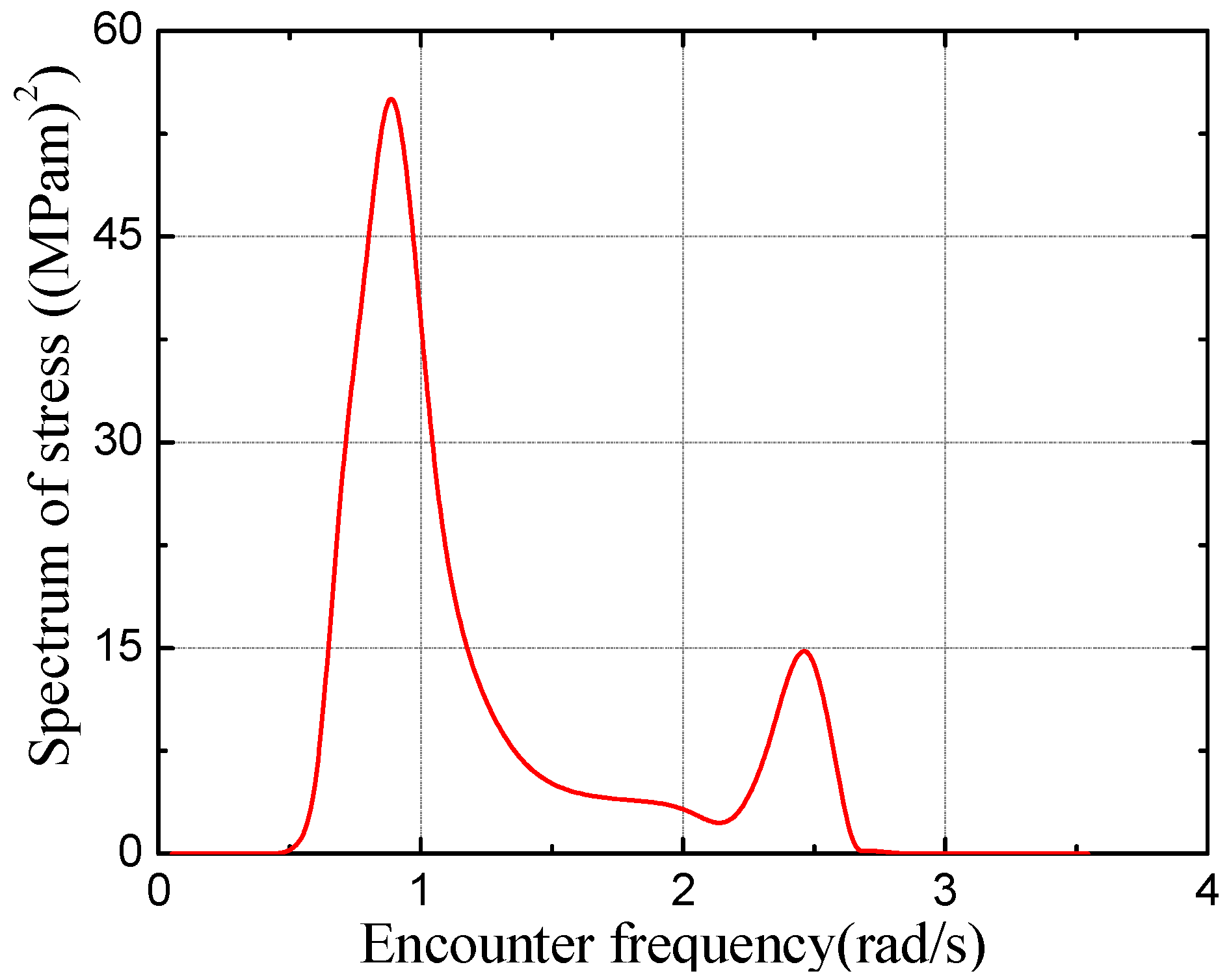
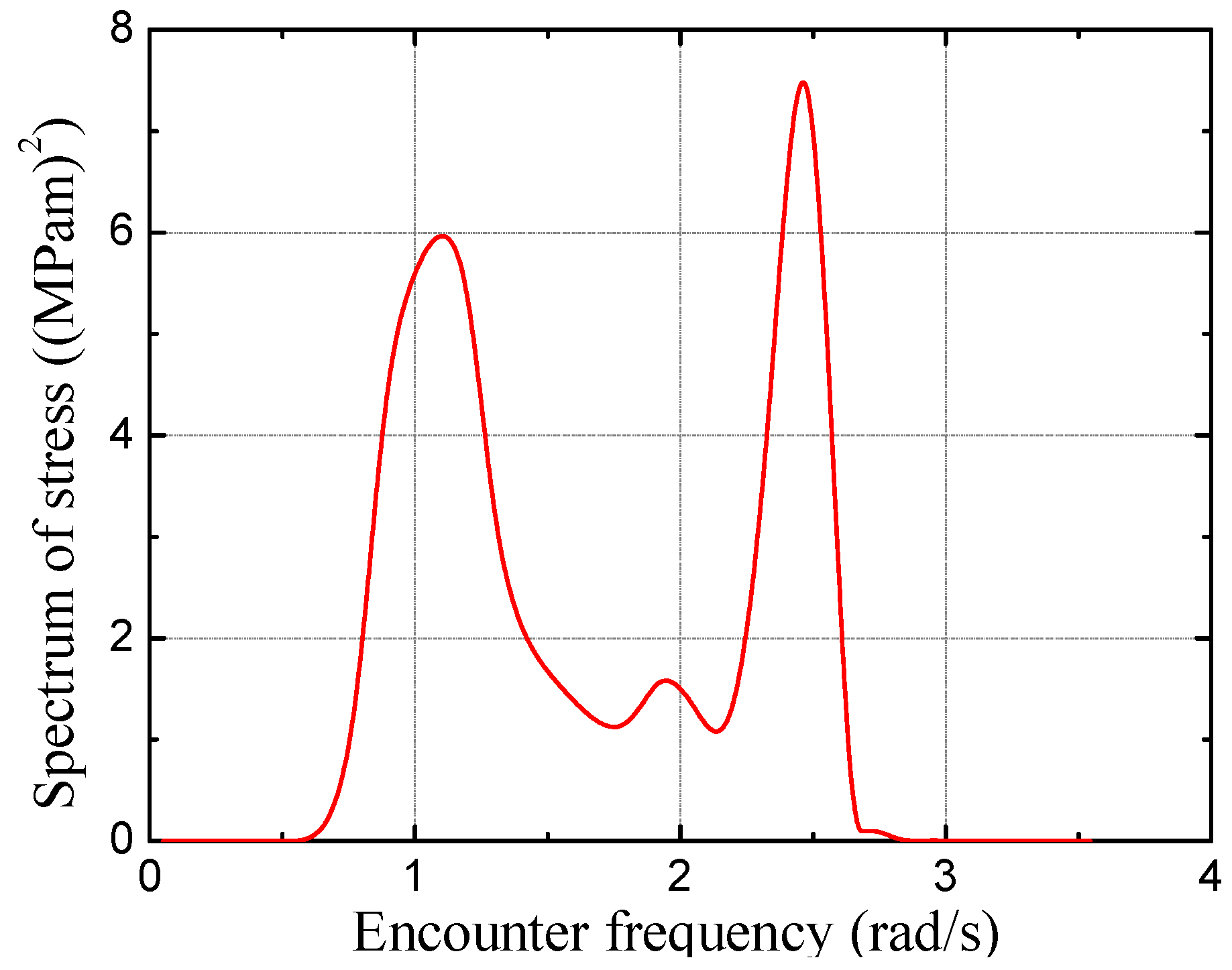
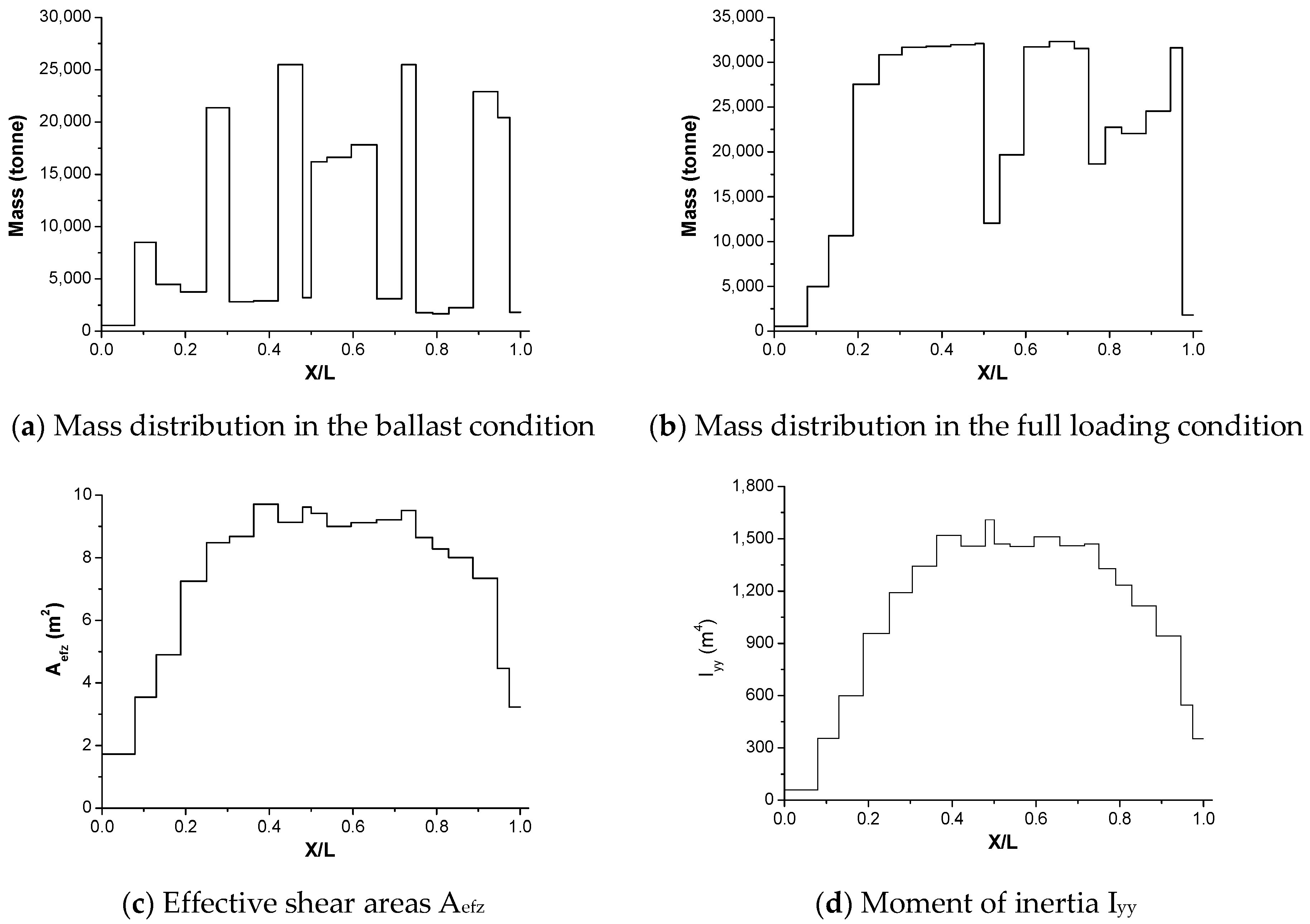
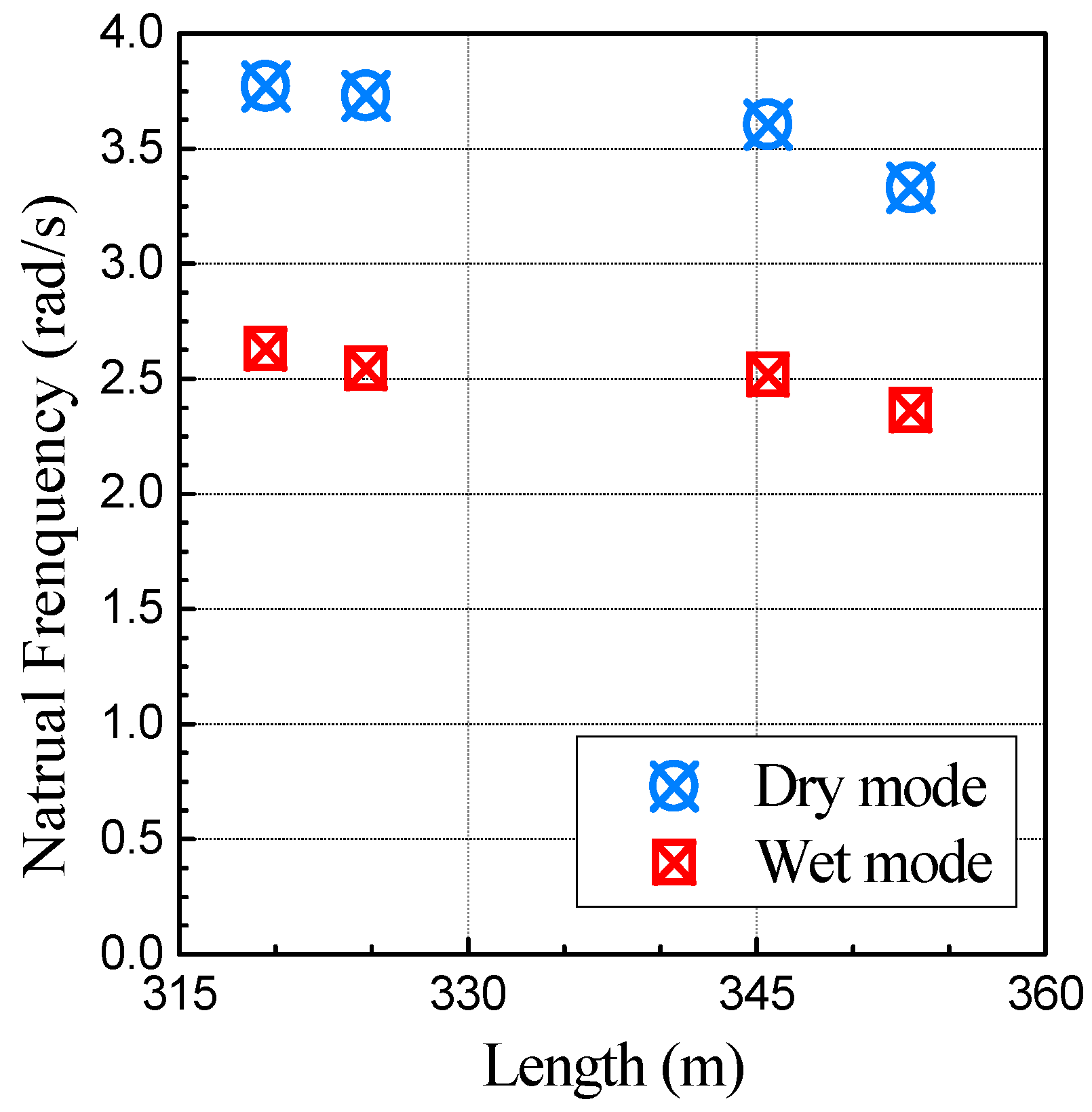
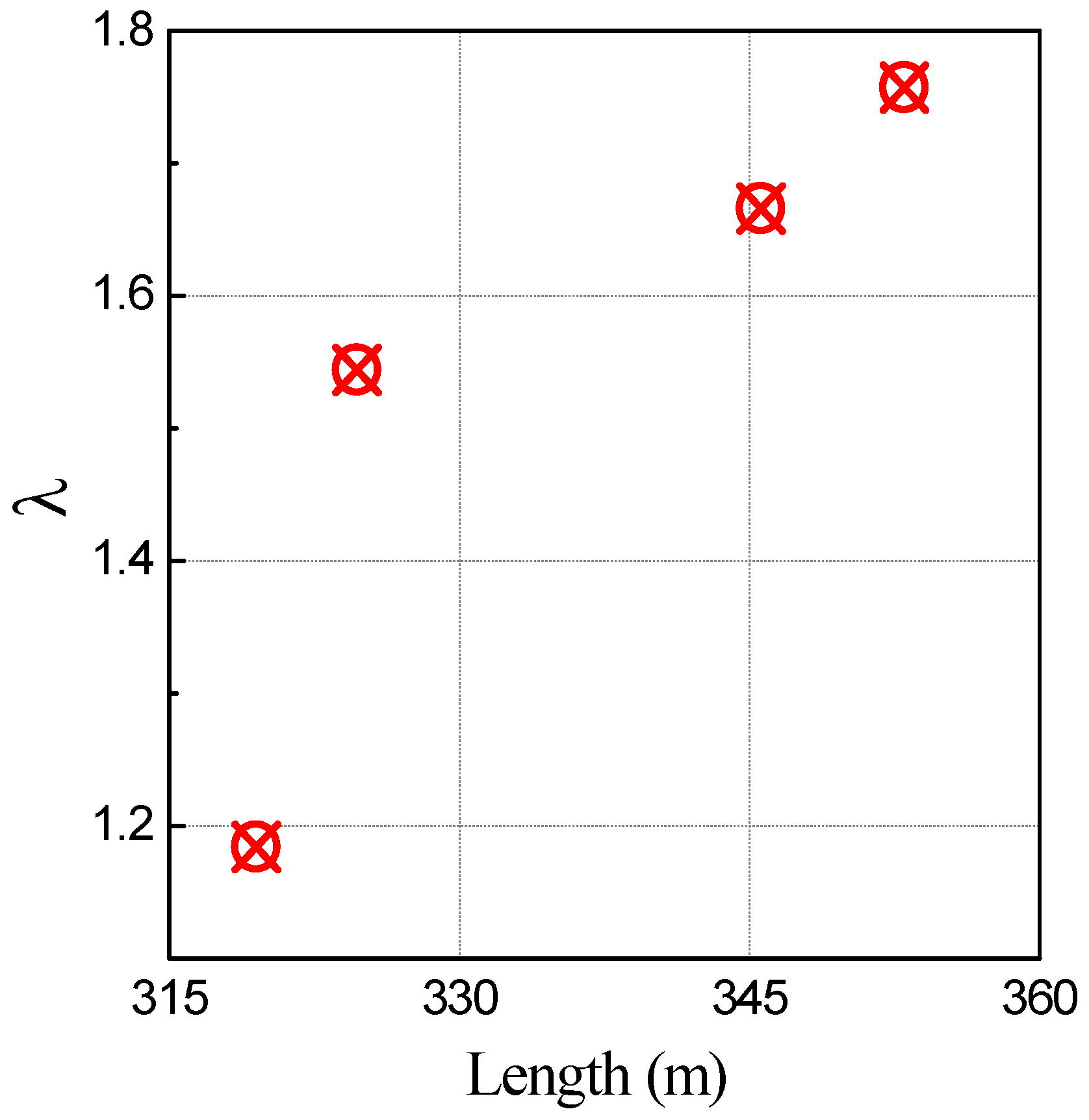
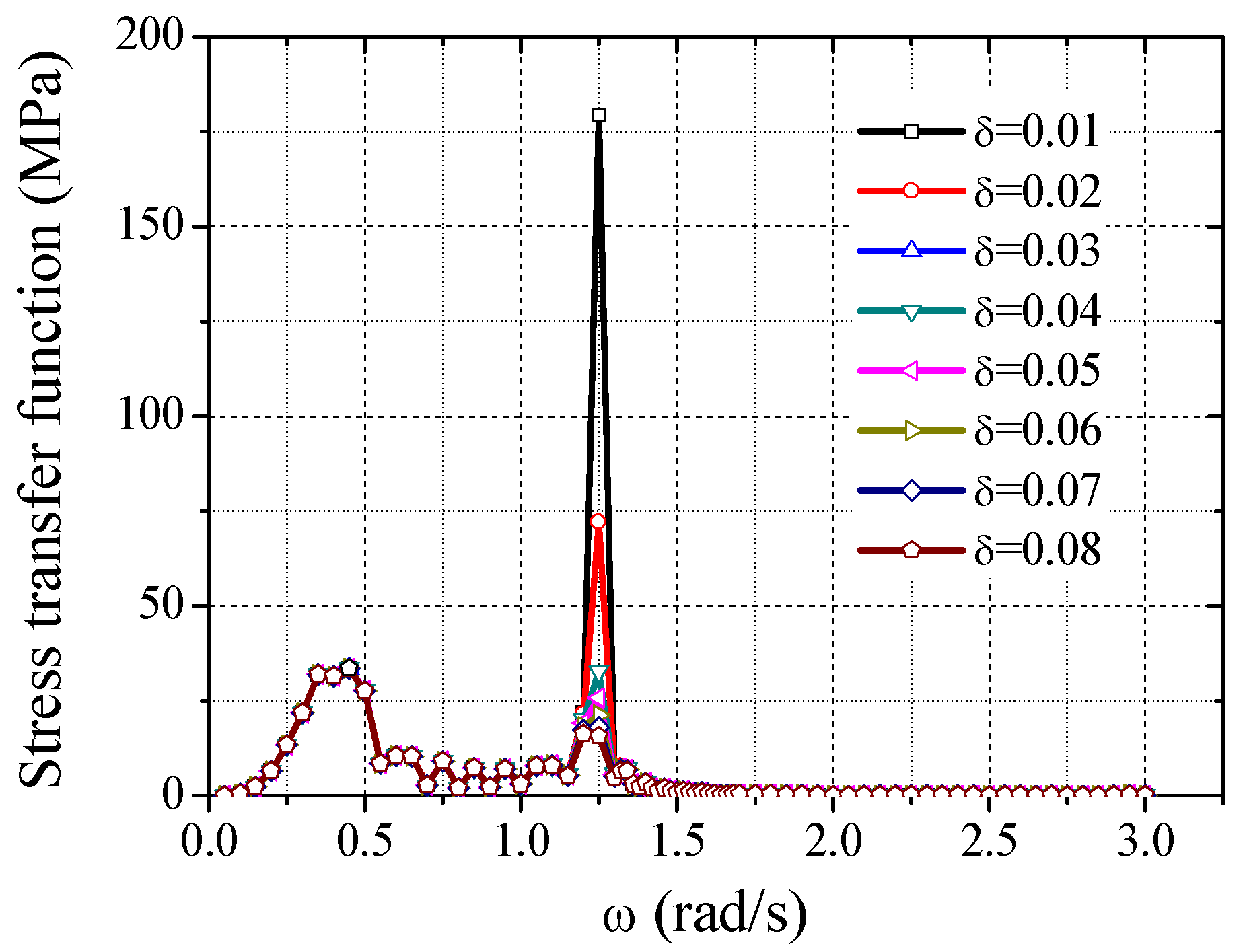
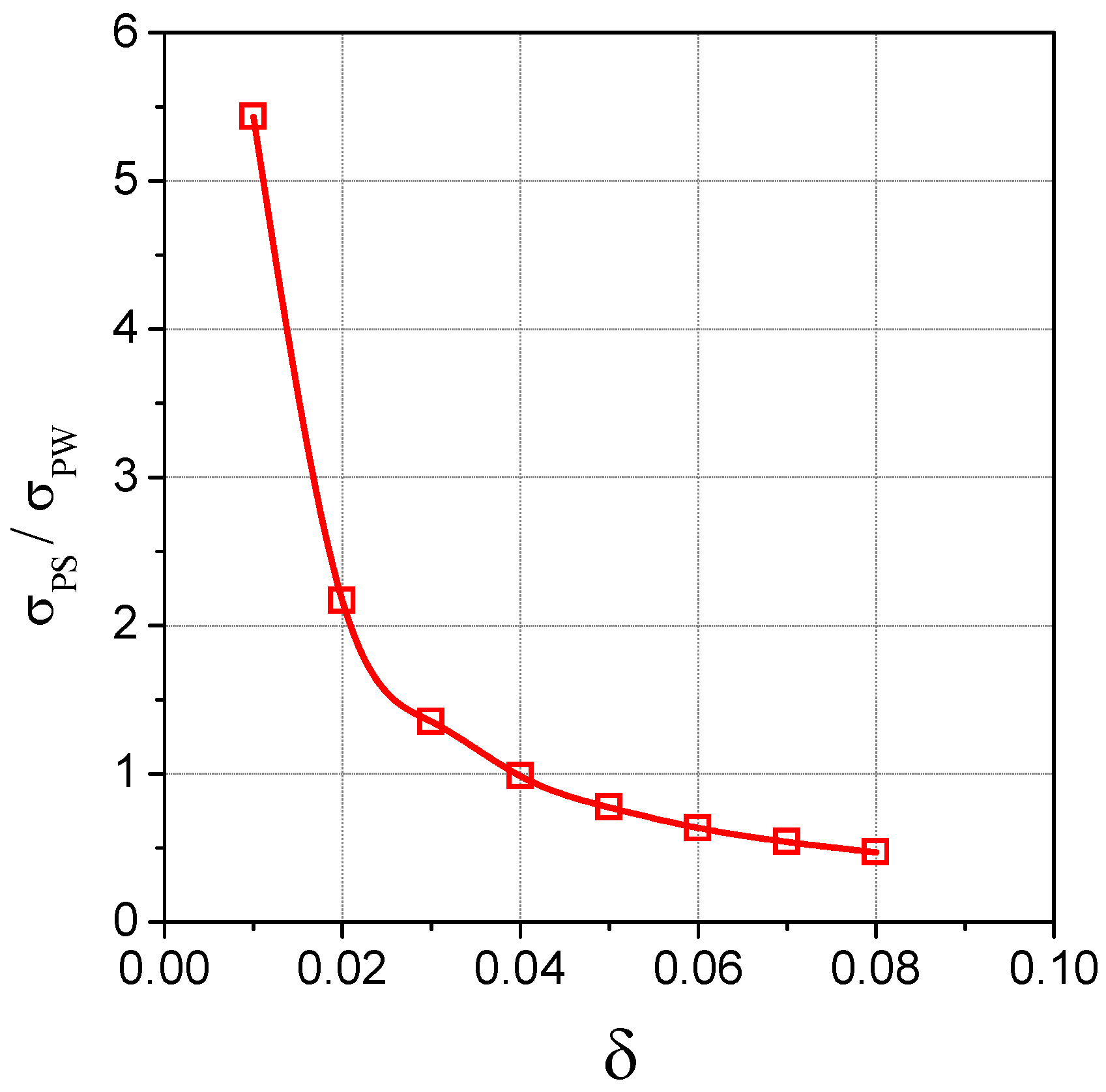
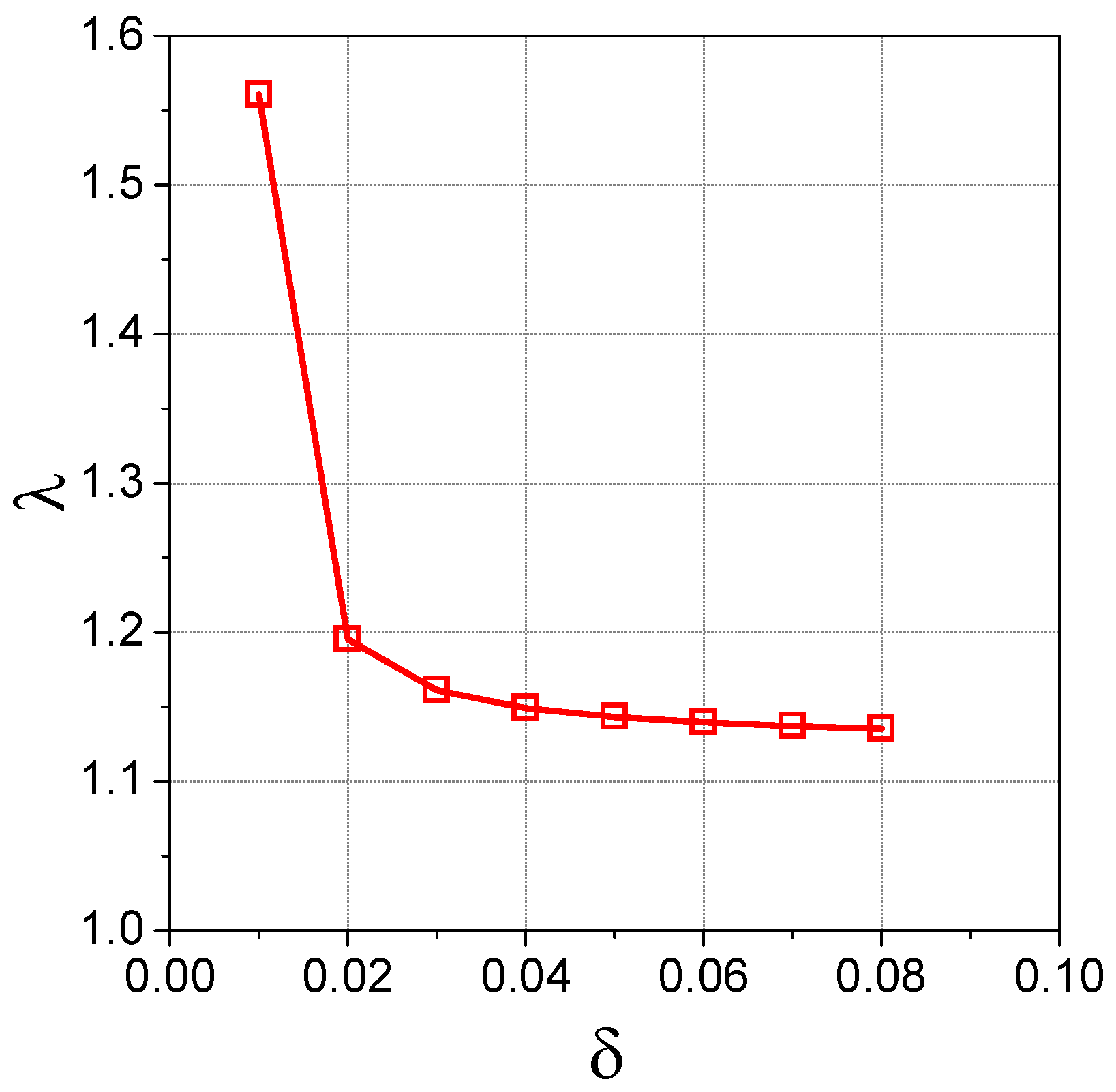


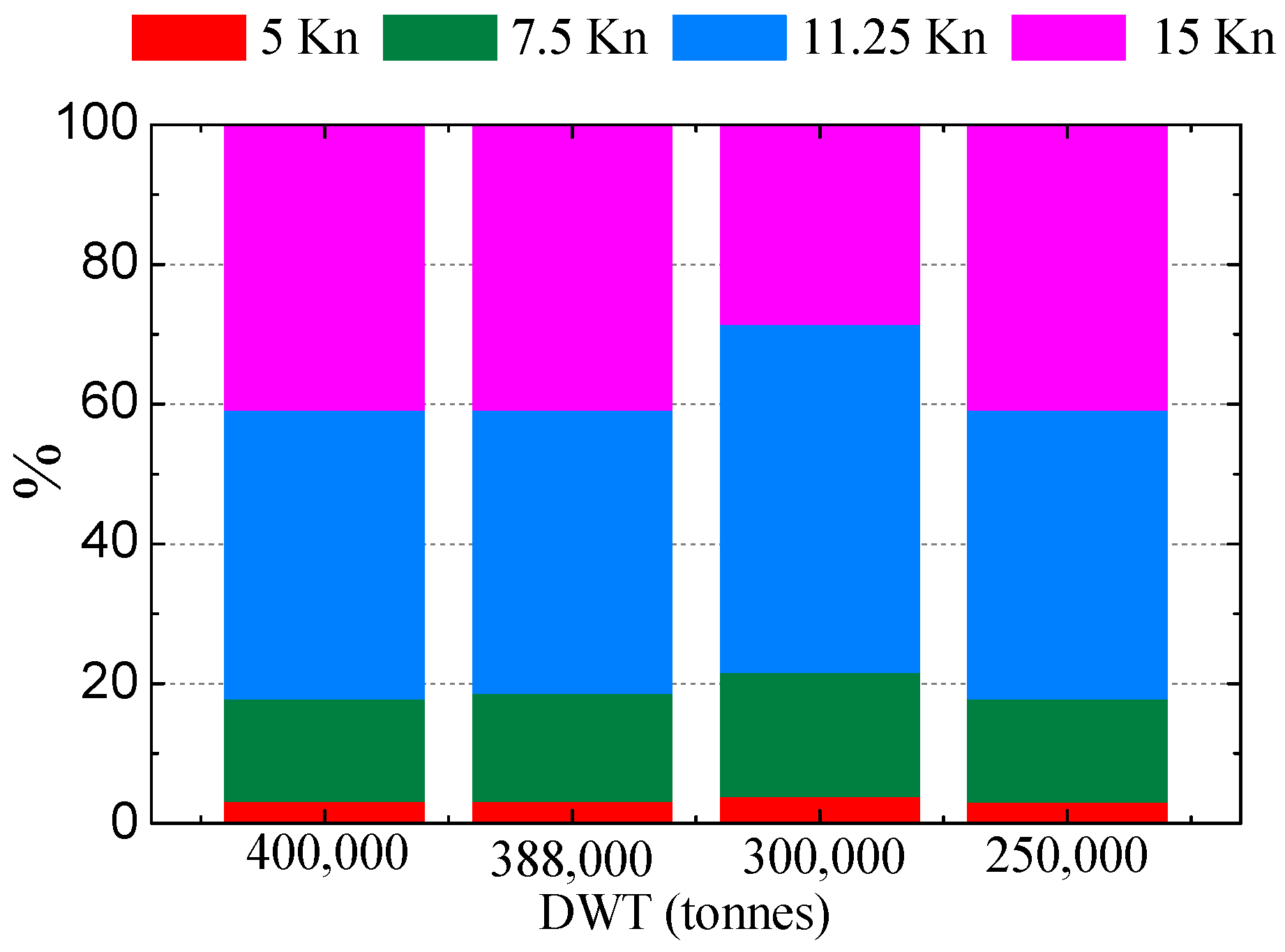
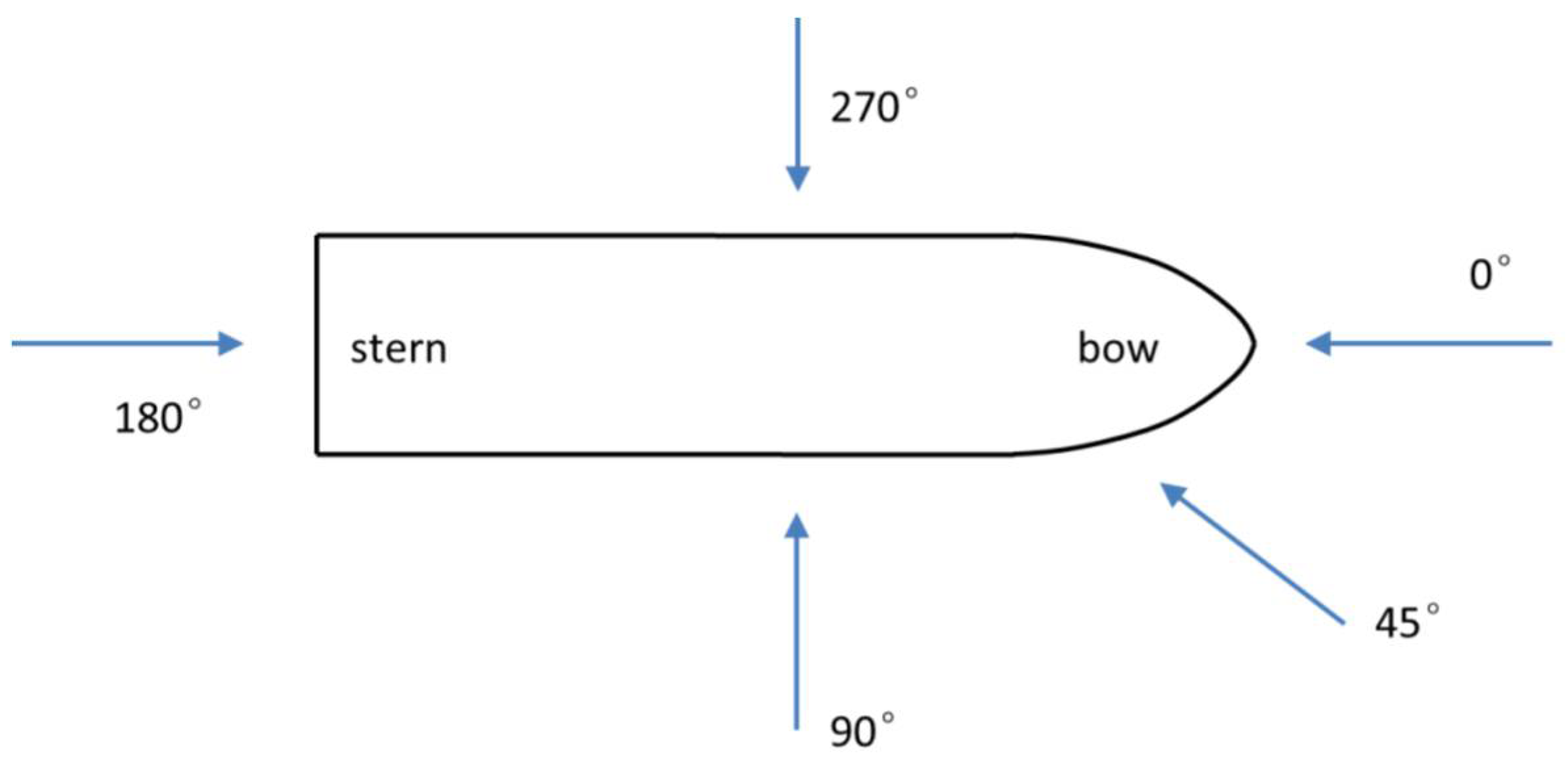
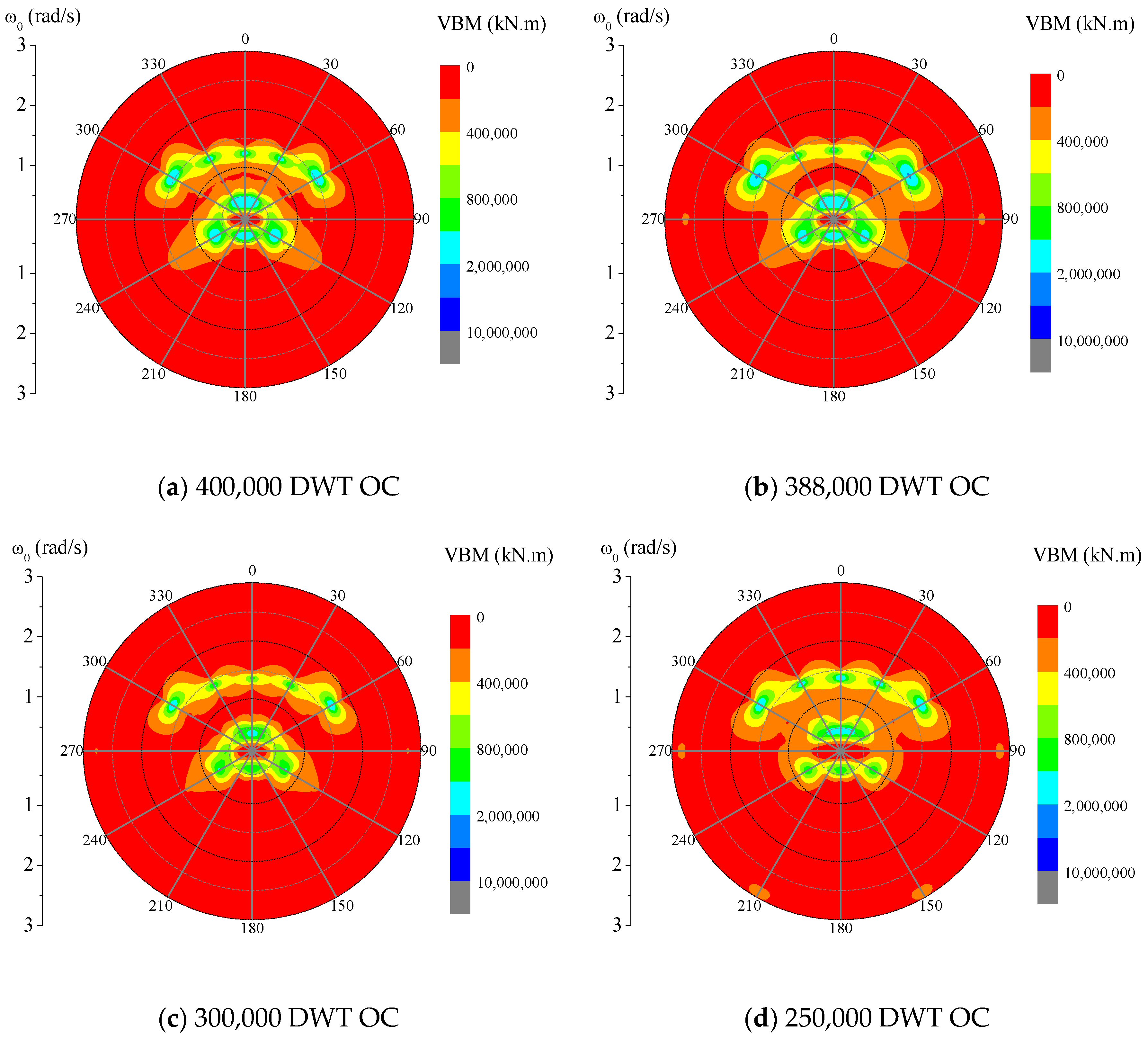
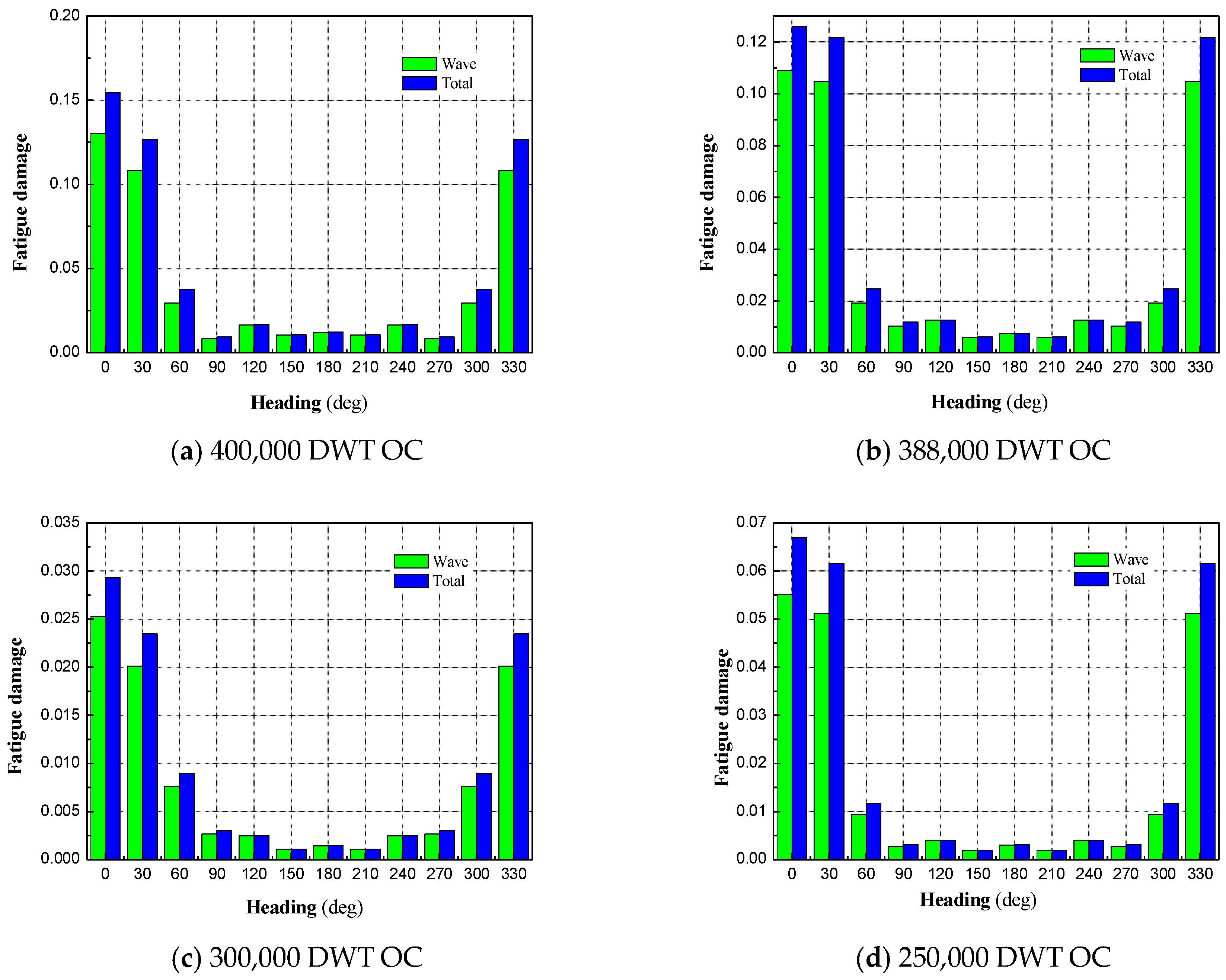
| 250,000 DWT OC | 300,000 DWT OC | 388,000 DWT OC | 400,000 DWT OC | |
|---|---|---|---|---|
| Length between perpendiculars LPP (m) | 319.5 | 324.7 | 345.6 | 353 |
| Beam B (m) | 57 | 57 | 65 | 65 |
| Depth D (m) | 26.4 | 28.8 | 30.5 | 30.4 |
| Displacement in full loading condition (tonnes) | 297,917 | 340,772 | 437,054.6 | 450,851.3 |
| Displacement in ballast condition(tonnes) | 159,512 | 206,813 | 259,082.7 | 248,551.2 |
| 250,000 DWT OC | 300,000 DWT OC | 388,000 DWT OC | 400,000 DWT OC | |
|---|---|---|---|---|
| Fatigue damage due to wave frequency load () | 0.197 | 0.095 | 0.422 | 0.489 |
| Total fatigue damage including springing () | 0.235 | 0.109 | 0.488 | 0.569 |
| Fatigue damage ratio including springing () | 1.193 | 1.150 | 1.155 | 1.163 |
| 250,000 DWT OC | 300,000 DWT OC | 388,000 DWT OC | 400,000 DWT OC | |
|---|---|---|---|---|
| Fatigue damage due to wave frequency load () | 0.545 | 0.17 | 0.248 | 0.475 |
| Total fatigue damage including springing () | 0.645 | 0.261 | 0.407 | 0.851 |
| Fatigue damage ratio including springing () | 1.184 | 1.534 | 1.643 | 1.794 |
| 250,000 DWT OC | 300,000 DWT OC | 388,000 DWT OC | 400,000 DWT OC | |
|---|---|---|---|---|
| Full loading condition | 1.192 | 1.143 | 1.153 | 1.159 |
| Ballast condition | 1.196 | 1.161 | 1.157 | 1.167 |
| Combined loading condition | 1.193 | 1.150 | 1.155 | 1.163 |
© 2018 by the authors. Licensee MDPI, Basel, Switzerland. This article is an open access article distributed under the terms and conditions of the Creative Commons Attribution (CC BY) license (http://creativecommons.org/licenses/by/4.0/).
Share and Cite
Li, H.; Wang, D.; Liu, N.; Zhou, X.; Ong, M.C. Influence of Linear Springing on the Fatigue Damage of Ultra Large Ore Carriers. Appl. Sci. 2018, 8, 763. https://doi.org/10.3390/app8050763
Li H, Wang D, Liu N, Zhou X, Ong MC. Influence of Linear Springing on the Fatigue Damage of Ultra Large Ore Carriers. Applied Sciences. 2018; 8(5):763. https://doi.org/10.3390/app8050763
Chicago/Turabian StyleLi, Hui, Di Wang, Ning Liu, Xueqian Zhou, and Muk Chen Ong. 2018. "Influence of Linear Springing on the Fatigue Damage of Ultra Large Ore Carriers" Applied Sciences 8, no. 5: 763. https://doi.org/10.3390/app8050763
APA StyleLi, H., Wang, D., Liu, N., Zhou, X., & Ong, M. C. (2018). Influence of Linear Springing on the Fatigue Damage of Ultra Large Ore Carriers. Applied Sciences, 8(5), 763. https://doi.org/10.3390/app8050763






